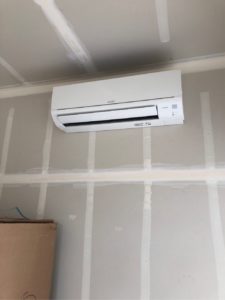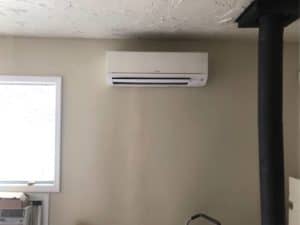 If your garage doubles as a workshop, rec room, home office or even a classroom, you’ll want to add heating so you can enjoy it all year long. Even if it’s just for parking your cars, adding a little hot air can make leaving for work in the wintertime a little more tolerable (especially if you have luxury vehicles).
If your garage doubles as a workshop, rec room, home office or even a classroom, you’ll want to add heating so you can enjoy it all year long. Even if it’s just for parking your cars, adding a little hot air can make leaving for work in the wintertime a little more tolerable (especially if you have luxury vehicles).
But, what’s the best way to do it? Odds are, you don’t have ductwork and a vent out there like you do with the rest of the house.
That’s because most home designs don’t consider that you’ll spend a lot of time in that part of the house.
As a result, heating your garage can be a little tricky. This situation even results in it being challenging to heat the bonus room above a garage.
But, there are plenty of options out there to consider. So, in this article, we’ll go through some of the challenges that come with heating a garage.
Then, we’ll look at the best ways to get it done.
And, if you’re looking for the best way to heat your garage in Caldwell, ID, or anywhere in the Treasure Valley, click below or call Snowflake Air at (208) 205-9078. We’re happy to help you make your entire home— including the garage — warm and comfortable all winter long.
Why Heating A Garage Can Be Challenging
There are two main reasons why heating a garage can be challenging:
- No Vents
- Poor Insulation
No Vents
Since garages aren’t considered living spaces, odds are you don’t have ductwork leading from the furnace to this part of the house. And, of course, no vents to pump warm air into the space.
That means, off the bat, you either need a separate heating source or make a significant investment in extending the ductwork into that room. But, the latter isn’t always a good idea.
First off, you don’t have a thermostat out there. As a result, it’ll tend to stay colder than the other rooms. Next, you have a furnace sized for the space it’s heating. When you add another large room, it may not be strong enough to accommodate the extra work.
Poor Insulation
 Next, you’re likely losing whatever warmth you get in the garage. Heat is attracted to cold and finds any path outside in the winter. With the garage, that’s under and around the garage door and through walls with no insulation.
Next, you’re likely losing whatever warmth you get in the garage. Heat is attracted to cold and finds any path outside in the winter. With the garage, that’s under and around the garage door and through walls with no insulation.
In fact, starting with insulation is an essential first step before getting a heater.
Insulating A Garage
Insulating your garage will help you make the most of whatever heating source you choose for this part of the house. After all, you don’t want all that warmth to escape as your system produces it.
Then, you’ll still be chilly, but you’ll have much higher energy bills.
So, start with fiberglass batt insulation on the walls. If you’re using the area for a workshop, you can save a few dollars and leave it exposed. But, for a little extra insulation, plus a better look and feel for a rec room, office or classroom, hang drywall to make it a finished room..
Either way, don’t forget the garage door! You’re losing a lot of heat there as well. With a bit of planning, you can add insulation without preventing the door from opening and closing.
Once you’re all set there, it’s time to pick out a heater!
Portable Heaters
We’re covering portable heaters first even though they’re really a last resort. Yes, you can get a space heater for anywhere from $60 to $200. But, they’ll use a lot of electricity. And, they don’t heat large spaces all that well.
You also can’t leave it on when you’re not in the room. They’re a fire hazard when left unattended for a long time. So, you’ll be starting with a cold room every time you turn it on.
The exception here is a permanently installed mountable ceiling or wall heater. These are more expensive but also designed to stay on for more extended periods.
Radiant Floor Heating
Radiant floor heating can be pricey, but you’ll get excellent heat all the time. If you’re not familiar, these are heating units that go in underneath your flooring. They provide heat that starts from there and rises through the entire room.
It’s just as powerful as a furnace. And, it’s concentrated in the room where you install it. That way, it does a better job than a heater that’s halfway across the house. And for a bonus, you can walk barefoot!
However, it’s expensive to install. And, you’ll need to put flooring over it. If you’ve already finished the garage floor, it’s not really an option.
Wood Burning Stove
A wood-burning stove keeps you warm while adding a cozy look and feel to the space. You get the advantages of a dedicated heating source just for this space. And, it’s not as expensive as radiant floor heating.
The cons? A little extra work on the installation because you’ll need to install an exhaust vent as well. That’s not to mention making sure you have pellets or wood on hand all the time. But, if you like the look and feel of it, this is a great option.
Ductless Mini Split
 When it comes to being practical, a ductless mini split is often the best way to heat a garage. And no, we’re not just saying that because we’re the mini split experts in this part of Idaho.
When it comes to being practical, a ductless mini split is often the best way to heat a garage. And no, we’re not just saying that because we’re the mini split experts in this part of Idaho.
In fact, we became the experts because we’ve seen how well they work!
The air handler has a built-in thermostat, so you get customized heating for that space. And it uses a fraction of the energy that any of these other solutions require.
Read More: How Do Mini Splits Work?
Plus, all you have to do is install a single air handler on your wall and connect a few lines from that unit to a heat pump outside.
Now, you’ll pay way more upfront: The cost of a mini split starts around $3,000. But, you’ll get plenty of advantages with it.
Read More: Rebates and Financing Options For Treasure Valley Heat Pump and Mini Split Installations
More Benefits Of Ductless Heating And Cooling
Along with heating one part of the house, ductless heating and cooling is also:
- Exceptionally Comfortable
- Easy To Install
- Able To Cool In The Summer
Exceptionally Comfortable
Air handlers do a better job of circulating warm air than a forced-air system with ducts and vents. They have sensors to locate cold pockets and specialized fans to treat those spots. They also keep the temperature within a degree of your setting all the time — something other systems can’t do.
Easy To Install
There’s no adding or extending ductwork. Nor do you need to get under the flooring. That makes the installation much easier and less invasive than other systems. We can get a single-zone system up and running in one day.
Able To Cool In The Summer
A mini split doubles as an air conditioner and works just as well with cooling as it does heating! That means you’ll get excellent climate control year-round.
Read Real Case Studies Of Mini Split Installations In Boise Metro and Valley County
Heat Pump And Mini Split Installation In Eagle, ID
Are you ready to learn more about how a mini split installation in your Eagle, ID home can keep your garage warm all winter long? Reach out to Snowflake Air today for your free consultation. We’re experts when it comes to mini splits, conventional heating, and HVAC in general. We’ll help you find the best heating strategy to fit your needs and your space. You can click below or reach us at (208) 205-9078.



